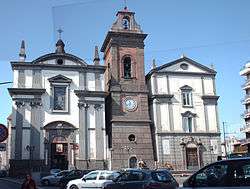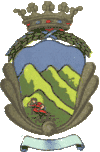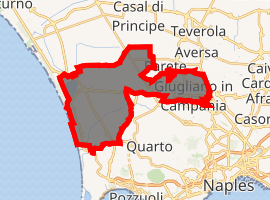Giugliano in Campania
Giugliano in Campania [dʒuʎˈʎaːno iŋ kamˈpaːnja], also known simply as Giugliano, is a city and comune in the Metropolitan City of Naples, Campania, Italy. As of 2017, it had some 124,000 inhabitants,[3] making it the most populated Italian city that is not a provincial capital.
Giugliano in Campania | |
|---|---|
| Comune di Giugliano in Campania | |
 Church of the Annunziata. | |
 Coat of arms | |
.svg.png) | |
Location of Giugliano in Campania 
| |
 Giugliano in Campania Location of Giugliano in Campania in Italy  Giugliano in Campania Giugliano in Campania (Campania) | |
| Coordinates: 40°56′N 14°12′E | |
| Country | Italy |
| Region | Campania |
| Metropolitan city | Naples (NA) |
| Frazioni | Lago Patria, Varcaturo, Licola |
| Government | |
| • Mayor | Antonio Poziello |
| Area | |
| • Total | 94.62 km2 (36.53 sq mi) |
| Population (31 August 2017)[2] | |
| • Total | 124,139 |
| • Density | 1,300/km2 (3,400/sq mi) |
| Demonym(s) | Giuglianesi |
| Time zone | UTC+1 (CET) |
| • Summer (DST) | UTC+2 (CEST) |
| Postal code | 80014 |
| Dialing code | 081 |
| Patron saint | St. Iulianus |
| Saint day | January 9 |
| Website | Official website |
History
In 5th-4th century BCE the territory of Giugliano was settled by the Osci. According to a tradition, the city was founded by a group of colonists from Cuma in 421 BCE, who called it Lilianum ("Land of the lilies").
Near "Lake Patria", there was the ancient city of Liternum. In 194 BC it became a Roman colony. The town is mainly famous as the residence of the elder Scipio Africanus, who withdrew from Rome and died there.[4] His tomb and villa are described by Seneca the Younger[5][6]. In 455, the town was pillaged and destroyed by Genseric and his Vandals.[7] The surviving population migrated to the present historical center of Giugliano.
The city remained a small center until 1207, when Cuma was destroyed by the Neapolitans; some of the citizens from that town, including the clergy and the cathedral capitular, took shelter in Giugliano. The first documents mentioning a fief in Giugliano dates from 1270.
Lords of the city were, in sequence, the Vulcano, Filomarino, Pignatelli, D'Aquino, Pinelli and Colonna.
Geography
It is located in a fertile coastal plain north of Naples, thus serving as a market for agricultural products to the city. The plain on which it sits was known in ancient Roman times as the Campania Felix.
Neighboring communes
Giugliano in Campania borders the following municipalities: Aversa, Casapesenna, Castel Volturno, Lusciano, Melito di Napoli, Mugnano di Napoli, Parete, Pozzuoli, Qualiano, Quarto, San Cipriano d'Aversa, Sant'Antimo, Trentola-Ducenta, Villa Literno and Villaricca.[8]
Main sights
- Palazzo Pinelli, built in 1545 by architect Giovanni Francesco di Palma. It had a side tower, which was later demolished.
- Church of Santa Sofia (17th century), designed by Domenico Fontana. It was finished in 1730-1745 by the Neapolitan architect Domenico Antonio Vaccaro. It houses the tomb of Giovan Battista Basile.
- Church of the Annunziata, known from the 16th century. It is home to several canvasses by Neapolitan artists such as Massimo Stanzione and Carlo Sellitto. it has a nave with apse and transept; the pulpit is in Roccoco style, while the rest of the interior is decorated in Baroque style. Notable are also the large wooden organ (late 16th century), the Chapel of Madonna della Pace and early 16th Stories of the Virgin' in the left transept.
- Church of Sant'Anna. Of the original building, existing in the 14th century, the bell tower remains. It houses 16th-century paintings by Fabrizio Santafede and Pietro Negroni.
- Church of Madonna delle Grazie, with a 14th-century bell tower and a 16th-century portal. The interior has a 15th-century Gothic Incoronation of the Virgin and early 16th-century frescoes.
- Church of Santa Maria della Purità or of the Souls of Purgatory(18th century). It was designed by Domenico Antonio Vaccaro, who also designed the internal stuccos and the covering of the dome, made as fish scales. The structure is an octagonal plant and has four altars, besides the greater one.
- Ancient town of Liternum. The excavations brought to light, between 1930 and 1936, some elements of the city center (forum with a temple, a basilica and a small theater) dating from the beginning of the Roman Empire. Outside the city walls, the remains of the amphitheater and the necropolis have been identified.
- Lake Patria, in the frazione of the same name, it was called by ancient Roman "Literna Palus". It is part of the Natural Reserve "Foce Volurno - Costa di Licola".
Transportation
Giugliano is served by Naples–Aversa railway, a railway suburban train connection to the Naples Metro. Another station, Giugliano-Qualiano, is located some kilometers outside the city. It is part of the Villa Literno–Naples line, a branch of the Rome–Formia–Naples railway.
Famous people
- Giovan Battista Basile, poet, courtier, and fairy tale collector
- Scipio Africanus, Roman general
- Adriana Basile, composer and singer
- Raffaele Cantone, magistrate
- Nicola Mignogna, politician and a significant contributor of “Risorgimento”
See also
References
- "Superficie di Comuni Province e Regioni italiane al 9 ottobre 2011". Istat. Retrieved 16 March 2019.
- "Popolazione Residente al 1° Gennaio 2018". Istat. Retrieved 16 March 2019.
- (in Italian) Source: Istat 2016
- AA., VV. (1826). A new guide of Naples, its environs, Procida, Ischia and Capri. p. 384.
- Seneca, Epistulae Morales 86
- Livy 48.52
- AA., VV. (1826). A new guide of Naples, its environs, Procida, Ischia and Capri. p. 386.
- 40849 Giugliano on OpenStreetMap
Bibliography
- Basile, Agostino (1800). Memorie istoriche della terra di Giugliano. Naples.
External links
| Wikimedia Commons has media related to Giugliano in Campania. |
- (in Italian) Giugliano official website
- Giugliano in Campania at Curlie
